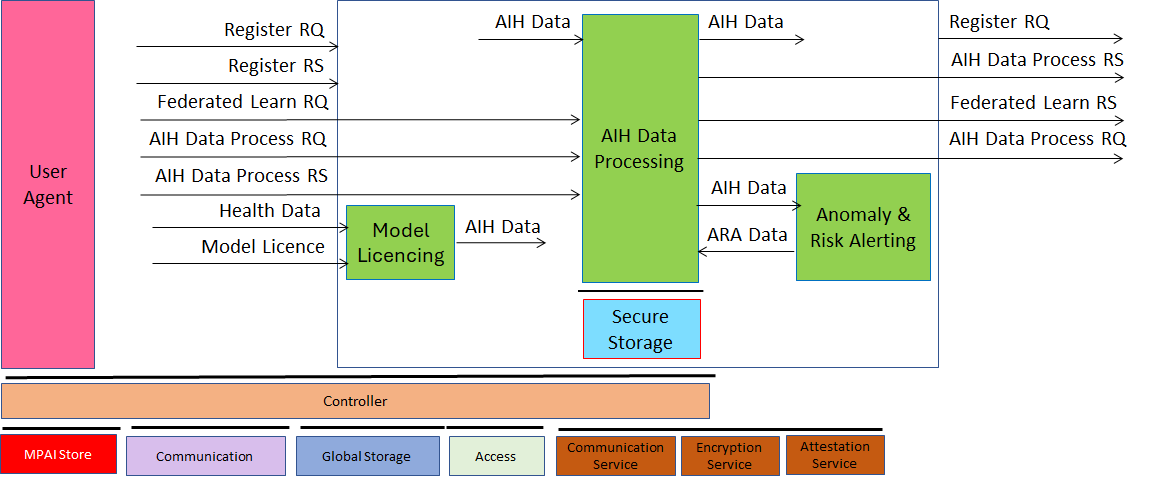| 1. Functions | 2. Reference Model | 3. Input/Output Data |
| 4. Functions of AI Modules | 5. Input/output Data of AI Modules | 6. AIW, AIMs, and JSON Metadata |
1. Functions
- The End User
- Registers with the Health Back End.
- Uses Health Devices to collect various types of Health Data.
- Provides a Model Licence to each Health Data collected.
- Requests the Health Front End to Process AIH Data.
- Sends AIH Data to the Health Back End.
- Requests The Back End to Process AIH Data.
- The Health Front End
- Stores AIH Data as combination of Model Licence and Health Data.
- Processes AIH Data.
- Adds Anomaly and Risk Alerting (ARA) Data, if present, to each AIH Data.
- Receives requests for trained NN Models from Health Back End.
- Sends its trained NN Models to the Health Back End for Federated Learning.
2. Reference Model
Figure 1 depicts the Reference Architecture of the Health Front End (AIH-HFE).

Figure 1 – Reference Model of the Health Front End (AIH-HFE) AIW
The HFE workflow develops as follows
- End User registers with HFE and HBE.
- End User acquire Health Data with a Health Device.
- End User attaches Model Licence to Health Data.
- Model Licencing stores AIH Data (including Health Data and Model Licence).
- End User process AIH Data locally.
- End User stores AIH Data to HFE.
- End User process AIH Data remotely.
- HFE receives Federated Learn request.
- HFE sends NN Model to HBE.
3. Input/Output Data
Table 2 specifies the Input and Output Data.
Table 1 – I/O Data of Health Front End
| Input | Description |
| Register Request | Data to request to Register. |
| Register Response | Data in response to a request to Register. |
| Federated Learn Request | Request to provide an NN Model. |
| AIH Data Process Request | End User’s Request to process specific AIH Data |
| AIH Data Process Response | End User’s Request to process specific AIH Data |
| Health Data | Data from End User’s health device. |
| Model Licence | Data Describing End User’s Licensing Terms and Conditions. |
| Output | Description |
| Register Request | Data to request to Register. |
| AIH Data Process Request | End User’s Request to process specific AIH Data |
| Federated Learn Response | Response to the request to provide an NN Model. |
4. Functions of AI Modules
Table 2 specifies the Function of the AI Modules.
Table 2 – Functions of Health Front End AI Modules
| AI Module | Description |
| Model Licensing | AIM adding Model Licence to Health Data. |
| AIH Data Processing | Processes AIH Data. |
| Anomaly and Risk Alerting | Discovers Anomalies and Risks in AIH Data. |
5. Input/output Data of AI Modules
Table 2 specifies the Function of the AI Modules.
Table 3 – Functions of Health Front End AI Modules
| Acronym | AI Module | Receives | Produces |
| AIH-MDL | Model Licensing | Health Data | AIH Data |
| Model Licence | |||
| AIH-HDP | AIH Data Processing | Federated Learn Request | Federated Learn Response |
| AIH Data Process Request | AIH Data Process Response | ||
| AIH Data Process Response | AIH Data Process Request | ||
| Health Data | |||
| Model Licence | |||
| AIH-ARA | Anomaly and Risk Alerting | AIH Data | ARA Data |
| Register Request | |||
| Register Response |
6. AIW, AIMs, and JSON Metadata
Table 4 provides the links to the AIW and AIM specifications and to the JSON syntaxes. AIMs/1 indicates that the column contains Composite AIMs and AIMs indicates that the column contains their Basic AIMs.
Table 4 – AIW, AIMs, and JSON Metadata
| AIW | AIMs | Name | JSON |
| AIH-HFE | Health Front End | X | |
| AIH-MDL | Model Licensing | X | |
| AIH-HFP | AIH Data Processing | X | |
| AIH-ARA | Anomaly and Risk Alerting | X |

